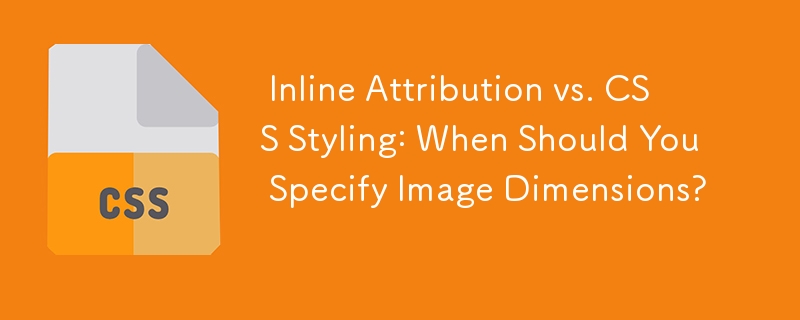Home >Web Front-end >CSS Tutorial >Inline Attribution vs. CSS Styling: When Should You Specify Image Dimensions?
Inline Attribution vs. CSS Styling: When Should You Specify Image Dimensions?
- Susan SarandonOriginal
- 2024-10-26 10:50:291162browse

Inline Attribution for Image Dimensions: Understanding Semantic Markup Practices
When specifying image dimensions, there are two primary options: setting them as an attribute within the image tag or utilizing CSS styling. This article delves into the nuances of both approaches, exploring the impact on semantics and accessibility.
Attribute Inline
Inline attribution specifies image height and width directly within the image tag, such as:
<code class="html"><img width="15"></code>
This approach provides a clear association between the image data and its dimensions. It also ensures that the image's size is intrinsic to the file itself, independent of any external styling.
CSS Styling
CSS styling allows for the manipulation of image dimensions through declarations like:
<code class="css">width: 15px;</code>
This approach offers flexibility and control over the image's presentation without altering the underlying data. However, it can lead to potential issues when the image's dimensions are crucial for layout or other semantic purposes.
Semantic Considerations
Semantic markup practices prioritize the use of inline attributes for defining intrinsic properties of an element, such as image dimensions. This approach ensures that the image's intended purpose and functionality are explicitly conveyed to browsers and assistive technologies.
Inline attribution also supports accessibility. Screen readers can accurately announce the image's dimensions, providing critical information for visually impaired users.
Layout Considerations
When an image serves solely for decorative or layout purposes, it may be appropriate to use CSS styling to control its dimensions. In such cases, the image does not carry semantic significance, reducing the need for explicit attribution.
Conclusion
The decision of whether to specify image dimensions as an attribute or in CSS depends on the image's intended use and semantic value. Inline attribution is generally preferred when preserving the image's intrinsic dimensions and accessibility is critical. CSS styling can be utilized for layout and presentation purposes, ensuring a consistent visual experience across different devices and context. By carefully considering these factors, developers can ensure that their images are both aesthetically pleasing and accessible to all users.
The above is the detailed content of Inline Attribution vs. CSS Styling: When Should You Specify Image Dimensions?. For more information, please follow other related articles on the PHP Chinese website!

